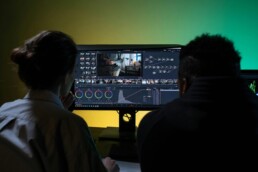Video Production Trends 2025
socialmrkt
As we approach 2025, the video production industry is poised for transformative advancements. Staying ahead of these trends is crucial for creators and businesses aiming to produce engaging and relevant content. Here are the top video production trends to watch in 2025:
Artificial Intelligence (AI) Integration
AI is revolutionizing video production by automating tasks such as editing, color correction, and even content generation. Tools like text-to-video models enable creators to produce videos from simple text prompts, streamlining the production process and reducing costs.
Virtual and Augmented Reality (VR/AR)
Immersive technologies are becoming more accessible, allowing creators to develop engaging experiences that captivate audiences. VR and AR are being utilized in various sectors, including education, training, and marketing, to provide interactive and memorable content.
Sustainable Video Production
Environmental consciousness is influencing production practices, with a growing emphasis on eco-friendly methods. Producers are adopting sustainable approaches, such as reducing carbon footprints and utilizing energy-efficient equipment, to meet the increasing demand for environmentally responsible content creation.
Short-Form and Mobile-First Content
The popularity of platforms like TikTok and Instagram Reels has solidified short-form, mobile-optimized videos as a dominant content format. Creators are focusing on producing concise, engaging videos tailored for mobile consumption to capture and retain audience attention.
Live Streaming and Real-Time Engagement
Live streaming continues to grow, offering real-time interaction between creators and audiences. This trend is being leveraged for events, product launches, and Q&A sessions, providing an authentic and immediate connection with viewers.
Personalized Video Content
Advancements in AI and data analytics enable the creation of personalized video experiences tailored to individual viewer preferences. This customization enhances engagement and fosters a deeper connection between the content and the audience.
High-Resolution and 360-Degree Videos
With the advent of 5G technology, streaming high-resolution (4K and 8K) and 360-degree videos is becoming more feasible. These formats offer immersive viewing experiences, making content more engaging and lifelike.
Emphasis on Storytelling and Authenticity
Audiences are increasingly valuing authentic and relatable content. Producers are focusing on storytelling that reflects genuine experiences and emotions, fostering a deeper connection with viewers and enhancing content impact. Staying informed about these trends will empower creators and businesses to adapt and thrive in the evolving landscape of video production as we move into 2025.
How To Create A Brand Story
socialmrkt
A compelling brand story is the foundation of impactful marketing. It’s what connects your audience to your brand, making it memorable and relatable. But how do you create a brand story that stands out in a crowded market? Here's a step-by-step guide to crafting a great brand story, from script to screen.


Why a Brand Story Matters
Your brand story is more than just a narrative—it's a strategic tool that establishes emotional connections, builds trust, and sets your business apart. A well-crafted story helps your audience understand who you are, what you stand for, and why they should care.

The Essential Elements of a Great Brand Story
Authenticity
Your story needs to reflect the true essence of your brand. Customers value transparency, so be honest about your origins, mission, and values.
Emotion
A successful brand story evokes emotion. Whether it's nostalgia, excitement, or hope, connecting on a human level makes your brand more relatable.
Clarity
Keep it simple. A clear and concise narrative ensures your audience understands your message without confusion.
Purpose
Every story should answer these questions: Why does your brand exist? What problem are you solving for your customers?
Characters
Introduce real people—your founders, employees, or customers—who embody your brand’s values. This personal touch humanizes your story.
The journey from storyboard to screen is a collaborative and iterative process that transforms a brand's message into a compelling visual narrative.
How to Create a Brand Story That Resonates
Define Your Purpose
Start by identifying your brand’s "why." What inspired your company? What problem are you solving? Your purpose will serve as the backbone of your story.
Know Your Audience
Understand who you’re speaking to. Tailor your story to resonate with your target audience’s needs, values, and aspirations.
Build a Narrative Arc
A great story has a beginning, middle, and end.Beginning: Introduce your brand and its purpose.Middle: Highlight challenges or milestones that shaped your journey.End: Showcase how you’re making an impact today and your vision for the future.
Incorporate Visuals
Bring your story to life with visuals that align with your brand's tone and personality. From imagery to video, these elements can enhance emotional impact.
Leverage Multiple Channels
Learning how to create a brand story is about finding the balance between authenticity, emotion, and purpose. A strong brand story not only differentiates your business but also forms lasting connections with your audience. From script to screen, the process of crafting your narrative can elevate your brand to new heights.
How to Maximize Video Marketing ROI
socialmrkt
Video marketing remains one of the most effective ways to engage audiences and drive results, but how can you ensure you're maximizing your return on investment (ROI)? By combining smart strategies with data-driven insights, you can make your video content work harder and deliver measurable outcomes for your business. Here's a step-by-step guide to maximizing video marketing ROI in 2025.


Define Clear Goals and Metrics
Start by outlining what success looks like for your video marketing efforts. Are you aiming to boost brand awareness, drive website traffic, or increase sales? Aligning your goals with measurable metrics will help you assess ROI effectively. Key performance indicators (KPIs) to consider include: Engagement rates (likes, shares, comments)Click-through rates (CTR)Conversion ratesView-through rates (VTR)
Focus on High-Impact Content
Not all videos are created equal. To get the most out of your budget, prioritize content that aligns with your audience's preferences and your business objectives: Explainer Videos: Simplify complex products or services to educate viewers. Testimonials and Case Studies: Build trust with authentic customer stories. Short-Form Content: Leverage platforms like TikTok and Instagram Reels to capture attention quickly.
Optimize Video Distribution
The right video distributed on the wrong platform can fail to perform. Ensure your content reaches the right audience by tailoring your distribution strategy: Social Media: Customize videos for platform-specific formats, such as vertical videos for Instagram Stories.Email Campaigns: Include video in email marketing to boost open and click rates.Paid Ads: Invest in targeted ad campaigns to reach specific demographics and maximize visibility.
Leverage Data and Analytics
Regularly review performance metrics to understand what's working and where you can improve. Use tools like Google Analytics, YouTube Studio, or social media insights to track: Audience demographicsDrop-off ratesEngagement trends Use these insights to refine your strategy, reallocate budgets, or experiment with new formats.
Repurpose Existing Content
Stretch your video marketing budget by repurposing existing content. Turn longer videos into bite-sized clips for social media, or transform webinar recordings into educational snippets. This approach reduces production costs while expanding your content’s lifespan.
Test and Iterate
Maximizing ROI requires continuous optimization. A/B test different video formats, lengths, and CTAs to see what resonates best with your audience. Small tweaks can lead to significant performance improvements over time.
Scale With Automation
Leverage automation tools to streamline video creation and distribution. AI-driven platforms can help with tasks like editing, captioning, and scheduling, allowing you to produce more content with less effort. Maximizing video marketing ROI is about more than creating great content—it’s about ensuring every element of your strategy works together to drive measurable results. By setting clear goals, focusing on impactful content, and leveraging analytics, you can turn your video marketing efforts into a powerful driver of business success.
The Psychology of Storytelling
socialmrkt

What is the psychology of storytelling? Storytelling is one of humanity’s oldest forms of communication. From ancient myths to modern movies, stories captivate, educate, and connect us. In advertising, storytelling has become a powerful tool to cut through the noise, forge emotional connections, and inspire action. But what makes a story effective? The answer lies in psychology—understanding how the human mind processes narratives and emotions. Let’s explore how storytelling in advertising taps into our psychology to drive engagement and impact.
At its core, storytelling in advertising works because humans are wired to respond to narratives. Neuroscience research shows that stories activate multiple areas of the brain, including those responsible for emotion, memory, and empathy. Unlike data or facts, stories create a full sensory experience, making them more memorable and persuasive. Advertisers use this psychological principle to build connections with their audience and create lasting impressions.
Key Principles
Emotional Resonance
Emotion is at the heart of effective storytelling. Whether it’s joy, nostalgia, fear, or hope, emotions make stories relatable and memorable. Advertisers often use emotional storytelling to tap into universal human experiences, creating a bond between the brand and the consumer. For example, a heartwarming story about a family pet may evoke feelings of love and loyalty, making viewers more likely to associate those emotions with the brand.
The Power of Empathy
Stories allow audiences to step into someone else’s shoes, fostering empathy. By presenting characters with relatable struggles, challenges, or aspirations, brands can connect on a deeper level with their audience. When viewers see themselves in a story, they’re more likely to engage with the message and take action.
The Narrative Arc
Humans naturally seek structure, and storytelling follows a predictable pattern: beginning, middle, and end. Known as the narrative arc, this structure satisfies our brain’s craving for resolution. Advertisers often craft stories with a clear conflict and resolution, ensuring the audience stays engaged until the message is delivered.
Memory
Stories are easier to remember than isolated facts or data. This is due to the way our brains organize information. Narrative structures help connect ideas, making them stick in long-term memory. Advertisers use this psychological advantage to ensure their message remains top of mind for consumers.
Dopamine
When a story evokes curiosity or suspense, our brains release dopamine—a neurotransmitter associated with pleasure and focus. This is why cliffhangers or unexpected twists in advertising campaigns keep audiences engaged. The payoff at the end of the story creates a satisfying experience, reinforcing the brand’s message.
Customers who feel emotionally connected to a brand are more likely to recommend it, purchase repeatedly, and even forgive occasional missteps.
Customers who feel emotionally connected to a brand are more likely to recommend it, purchase repeatedly, and even forgive occasional missteps.
How do you leverage these principals?
1. Building a Relatable Protagonist Effective advertising often features characters or situations that reflect the audience’s own experiences. Whether it’s a busy parent juggling responsibilities or a young professional chasing dreams, relatability creates a personal connection that draws viewers in. 2. Evoking Emotional Highs and Lows Great stories take audiences on an emotional journey, from moments of tension to uplifting resolutions. Advertisers strategically use these peaks and valleys to keep viewers engaged and leave a lasting impression. 3. Crafting a Purpose-Driven Narrative In today’s socially conscious world, consumers resonate with brands that tell purpose-driven stories. Ads that showcase a company’s commitment to sustainability, inclusivity, or community support often leave a deeper emotional impact.
As technology evolves, storytelling in advertising is becoming even more immersive. Augmented reality (AR), virtual reality (VR), and interactive videos allow consumers to become active participants in the story, deepening their emotional connection with the brand. Additionally, data-driven insights enable advertisers to craft hyper-personalized narratives, making storytelling more impactful than ever. If you’re ready to transform your brand’s messaging with powerful storytelling, contact us today to start creating narratives that truly connect.
Behind the Scenes Video Production: Remus Bourbon
socialmrkt
Behind the Scenes: Remus Bourbon’s “The Eras” Commercial
In the realm of creative storytelling, certain projects stand out for their ambition and innovation. The tale of Remus Bourbon’s brand history and its infamous founder is one such endeavor—a challenge that sparked the imagination of Story Brand Agency and brought the expertise of 90 Degrees West to the forefront. Together, we embarked on a journey to traverse multiple eras within the confines of a captivating 30-second commercial. From the very beginning, the mission was clear: immortalize Remus Bourbon’s story. The brand sought to honor the glamour and intrigue of the Prohibition Era while celebrating the timeless sophistication of bourbon through the ages. However, our team faced an intriguing challenge—how to authentically capture the essence of distinct eras, seamlessly weave them together, and maintain a high-quality production, all within a manageable budget.
The Creative Solution: A Timeless Continuous Shot
After much brainstorming and experimentation, the solution became clear: a continuous shot approach. This technique allowed the camera to glide fluidly along the length of a meticulously styled tabletop, transitioning seamlessly between different time periods. The tabletop itself became a stage, adorned with intricate props that represented each era. The continuous motion maintained visual cohesion while elegantly leading viewers through history.
The Magic of Wardrobe: Era-Specific Transformations
One of the most impressive elements of the shoot was the ingenuity of the wardrobe team. They faced the challenge of outfitting a single actor in era-specific attire at three key points during the tabletop journey. Using expertly crafted tearaway garments, the actor was able to transform swiftly, like a quick-change magician, without interrupting the camera’s unbroken movement. This seamless interplay of design and execution brought the story to life in a way that felt effortless yet undeniably striking.
Props as Storytellers: Adding Authenticity and Charm
Central to the success of this project was the art of prop selection. Every item on the tabletop was chosen with intention, not just as a visual representation of the era, but as a narrative device that added depth to Remus Bourbon’s story. These props became storytellers in their own right, weaving together a tapestry of authenticity and charm. Together, they evoked a sense of nostalgia while anchoring viewers in each time period.
Raising a Glass to Creativity and Craftsmanship
This project was more than a commercial; it was a celebration of visual storytelling and creative collaboration. From the seamless transitions to the era-specific details, every element worked in harmony to honor the legacy of Remus Bourbon.
The Final Spot
Brand Safe Social Content
socialmrkt
In the fast-paced world of video production, precision is everything. From framing the perfect shot to designing seamless graphics, every detail matters—especially when it comes to creating brand-safe social content. Even a minor mistake can compromise the quality of your final product or misalign with your brand’s identity. This is where safe zone templates become invaluable. These templates act as the guardrails for ensuring your social media content meets industry standards while maintaining a polished and professional look. By adhering to these guidelines, you can simplify the editing process, avoid critical design errors, and ensure your message is delivered exactly as intended. Not only do safe zone templates improve the viewer experience, but they also protect your brand’s reputation. By keeping key elements like logos, text, and calls-to-action within the safe zones, you can guarantee that your content looks professional across all platforms, reinforcing your commitment to quality and brand integrity.





